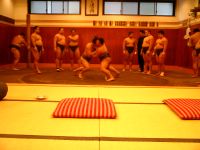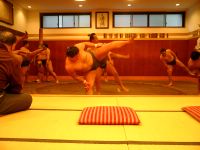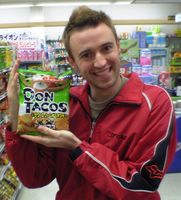Sumo Practice
My brother and I went to a Sumo Stable to watch the early morning Sumo practice today. We made the trek to the Sumo side of town and got to Tokitsukaze Beya at about 8:30 when the lower ranking Sumo were just starting their practice.
The Sumo dojo didn't look anything like I expected on the outside. I barely managed to find it because it was just a door in a large apartment building. There was a little note in English outside the door saying to use the intercom to watch practice, and a tiny sign in Japanese only with the name of the dojo (something something wind).
I'd been warned to be super polite at the Sumo dojos, so I pressed the little intercom button and waited. For 5 minutes. We could hear some movement inside, but we just waited to be polite. Eventually I pressed it again, and they said we could come inside.
After some confusion about where to sit (in the back) and what to sit on (the normal cushions, not the fancy ones), we settled down to watch. After all of my worrying about formality, I looked down and saw that my brother had a big hole in his sock. Of course, most people in America don't think about the condition of their socks when going out, but it's obviously more important in Japan where you take your shoes off in anyone's house, and many restaurants. There was one other visitor there; a large Japanese man who obviously had something to do with Sumo, unlike us, so he was sitting up front.
The room had a large tatami mat area for visitors and then the floor dropped down about 2 feet to a dirt floor with a large Sumo circle (doyo) in the middle. It's pretty amazing to see something (dirt) that you normally only see outside given such a place of prominence in a fancy Japanese room.
Since we had arrived fairly early, the lower ranked Sumo wrestlers (rikishi) were still practicing. We were surprised at how skinny some of them were. In fact, one of the wrestlers who consistently won his bouts was one of the skinniest there! His size showed up in the pushing practice at the end where wrestlers had to push another wrestler across the ring, sliding him on the dirt.
 Lower ranking wrestlers in a practice bout.
Lower ranking wrestlers in a practice bout.
The wrestler in the back left is practicing his Sumo slaps by hitting a big wooden pole. This went on for the whole practice (with various different Sumo) creating a hypnotic counterpoint to the bouts.
 Sumo stomp!
Sumo stomp!
It's amazing how flexible some of those big guys are.
The wrestlers enter the ring and then wait until they are both ready for the bout. They crouch down at their respective lines, and as soon as all 4 hands are touching the ground, they start. Putting their hands down to start the match is a waiting game. Usually one wrestler will put their hands down first, and then other one will put one down and then lightly touch the last hand to the ground before they slam into each other. Once they start the match, they will try to push each other out of the ring, or cause their opponent to fall down or touch the surface of the ring with any part of their body other than their feet. They will often slap their opponent to try to unbalance them, or grab their loincloth to hoist them off their feet.
Here's some video of one of the more impressive bouts between the higher level Sumo. One of them got pushed out of the ring so hard he slammed against the wall. You can tell they are higher ranking because they are wearing white loincloths, and they each have a lower ranking wrestler holding their towel. The higher ranked wrestlers are the only ones allowed to scatter salt to purify the ring before they make their entrance.
It was very impressive to watch the higher ranked Sumos in practice bouts with the lower ranked wrestlers. It really showed you how much skill is involved, rather than just sheer bulk. In 45 minutes of practice, we only saw one lower ranked wrestler beat a higher ranked wrestler, and the winner was actually one of the smaller wrestlers!
After the practice, we headed over to the Sumo museum, located in the basement of the Sumo Stadium. It was all in Japanese, but we did get to look at pictures of all the champions (yokozuna) over the years. Their size has definitely increased (picture the Hawaiian born Akebono), but there was one really skinny champion from the 70's (I think) who was actually from Colorado!
We then wandered around the neighborhood, which is packed with Sumo beya and Sumo Chanko Nabe restaurants. Chanko Nabe is Sumo soup and we picked a restaurant at random and went in to sample the soup. Chanko Nabe is mostly vegetables and tofu, with some chicken (plain and ground) tossed in for protein. Of course, the serving sizes are huge. My brother and I barely managed to finish off one bowl between the two of us. The bring the broth to a boil in a big iron pot on your table, and then you add the vegetables and meat to the broth as you're ready for more food.
After retirement, many Sumo start Chanko Nabe restaurants, and this one was no exception. There was a trophy wall filled with old pictures of a Sumo wrestler. During our lunch, a little Japanese girl came back from school and played with us for a while. Apparently she was the granddaughter of the Sumo who started the restaurant (as we were informed by another patron).
 Sumo Chanko Nabe Girl
Sumo Chanko Nabe Girl
She came in and bounced all over the restaurant, whereupon the waitresses urged her to practice her English with us, so she came over and said hello. After that, she switched back to Japanese. She spent a lot of her time sitting on just her butt and bouncing up and down. She was mostly interested if we could do the same trick. She also liked to squat like a frog and jump high in the air and made me take video of her doing it. She was a bundle of energy, and a great way to end our trip to Sumo town.
Info on Tokitsukaze beya.
Tokitsukaze-beya, Ryogoku 3-15-4, Sumida-ku, Tokyo 130-0026
東京都墨田区両国3丁目15-4時津風部屋
Yahoo map
03-5600-2561
For other stables, see the Quirky Japan site.
The Sumo dojo didn't look anything like I expected on the outside. I barely managed to find it because it was just a door in a large apartment building. There was a little note in English outside the door saying to use the intercom to watch practice, and a tiny sign in Japanese only with the name of the dojo (something something wind).
I'd been warned to be super polite at the Sumo dojos, so I pressed the little intercom button and waited. For 5 minutes. We could hear some movement inside, but we just waited to be polite. Eventually I pressed it again, and they said we could come inside.
After some confusion about where to sit (in the back) and what to sit on (the normal cushions, not the fancy ones), we settled down to watch. After all of my worrying about formality, I looked down and saw that my brother had a big hole in his sock. Of course, most people in America don't think about the condition of their socks when going out, but it's obviously more important in Japan where you take your shoes off in anyone's house, and many restaurants. There was one other visitor there; a large Japanese man who obviously had something to do with Sumo, unlike us, so he was sitting up front.
The room had a large tatami mat area for visitors and then the floor dropped down about 2 feet to a dirt floor with a large Sumo circle (doyo) in the middle. It's pretty amazing to see something (dirt) that you normally only see outside given such a place of prominence in a fancy Japanese room.
Since we had arrived fairly early, the lower ranked Sumo wrestlers (rikishi) were still practicing. We were surprised at how skinny some of them were. In fact, one of the wrestlers who consistently won his bouts was one of the skinniest there! His size showed up in the pushing practice at the end where wrestlers had to push another wrestler across the ring, sliding him on the dirt.
 Lower ranking wrestlers in a practice bout.
Lower ranking wrestlers in a practice bout.The wrestler in the back left is practicing his Sumo slaps by hitting a big wooden pole. This went on for the whole practice (with various different Sumo) creating a hypnotic counterpoint to the bouts.
 Sumo stomp!
Sumo stomp!It's amazing how flexible some of those big guys are.
The wrestlers enter the ring and then wait until they are both ready for the bout. They crouch down at their respective lines, and as soon as all 4 hands are touching the ground, they start. Putting their hands down to start the match is a waiting game. Usually one wrestler will put their hands down first, and then other one will put one down and then lightly touch the last hand to the ground before they slam into each other. Once they start the match, they will try to push each other out of the ring, or cause their opponent to fall down or touch the surface of the ring with any part of their body other than their feet. They will often slap their opponent to try to unbalance them, or grab their loincloth to hoist them off their feet.
Here's some video of one of the more impressive bouts between the higher level Sumo. One of them got pushed out of the ring so hard he slammed against the wall. You can tell they are higher ranking because they are wearing white loincloths, and they each have a lower ranking wrestler holding their towel. The higher ranked wrestlers are the only ones allowed to scatter salt to purify the ring before they make their entrance.
It was very impressive to watch the higher ranked Sumos in practice bouts with the lower ranked wrestlers. It really showed you how much skill is involved, rather than just sheer bulk. In 45 minutes of practice, we only saw one lower ranked wrestler beat a higher ranked wrestler, and the winner was actually one of the smaller wrestlers!
After the practice, we headed over to the Sumo museum, located in the basement of the Sumo Stadium. It was all in Japanese, but we did get to look at pictures of all the champions (yokozuna) over the years. Their size has definitely increased (picture the Hawaiian born Akebono), but there was one really skinny champion from the 70's (I think) who was actually from Colorado!
We then wandered around the neighborhood, which is packed with Sumo beya and Sumo Chanko Nabe restaurants. Chanko Nabe is Sumo soup and we picked a restaurant at random and went in to sample the soup. Chanko Nabe is mostly vegetables and tofu, with some chicken (plain and ground) tossed in for protein. Of course, the serving sizes are huge. My brother and I barely managed to finish off one bowl between the two of us. The bring the broth to a boil in a big iron pot on your table, and then you add the vegetables and meat to the broth as you're ready for more food.
After retirement, many Sumo start Chanko Nabe restaurants, and this one was no exception. There was a trophy wall filled with old pictures of a Sumo wrestler. During our lunch, a little Japanese girl came back from school and played with us for a while. Apparently she was the granddaughter of the Sumo who started the restaurant (as we were informed by another patron).
 Sumo Chanko Nabe Girl
Sumo Chanko Nabe GirlShe came in and bounced all over the restaurant, whereupon the waitresses urged her to practice her English with us, so she came over and said hello. After that, she switched back to Japanese. She spent a lot of her time sitting on just her butt and bouncing up and down. She was mostly interested if we could do the same trick. She also liked to squat like a frog and jump high in the air and made me take video of her doing it. She was a bundle of energy, and a great way to end our trip to Sumo town.
Info on Tokitsukaze beya.
Tokitsukaze-beya, Ryogoku 3-15-4, Sumida-ku, Tokyo 130-0026
東京都墨田区両国3丁目15-4時津風部屋
Yahoo map
03-5600-2561
For other stables, see the Quirky Japan site.
 Nikko:
Nikko: 
